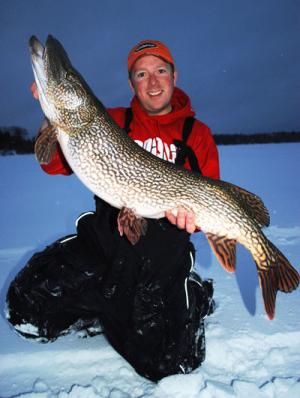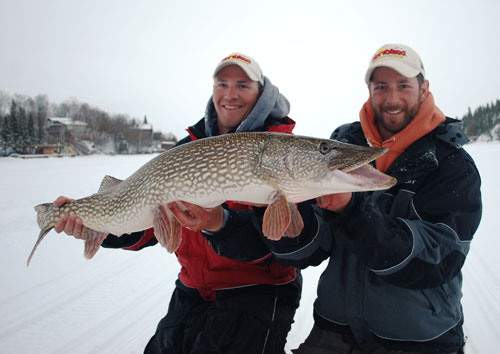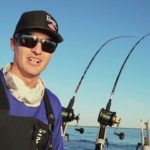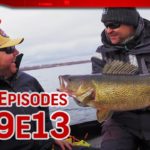Going for Gators through the Ice
 Northern pike may be one of the most widely distributed fish species throughout northwestern Ontario, yet only a handful of anglers consciously target this species during the winter months. Often considered a nuisance by some anglers, pike don’t seem to earn the same levels of appreciation as species such as walleye or trout. There is, however, a relatively small group of anglers that have fallen victim to the addictiveness of pulling large, toothy critters through the ice after a heart pumping battle.
Northern pike may be one of the most widely distributed fish species throughout northwestern Ontario, yet only a handful of anglers consciously target this species during the winter months. Often considered a nuisance by some anglers, pike don’t seem to earn the same levels of appreciation as species such as walleye or trout. There is, however, a relatively small group of anglers that have fallen victim to the addictiveness of pulling large, toothy critters through the ice after a heart pumping battle.
Dave Bennett and Jeff Gustafson of Kenora are two such hard-water anglers who have succumbed to this trophy pike addiction. Both of these successful tournament anglers and guides spend their winters cruising Lake of the Woods in search of the largest, finest specimens of walleye, crappie, lake trout, perch, whitefish and, of course, northern pike! The abundance and variety of forage mixed with a seemingly endless amount of great habitat characteristic to Lake of the Woods, are a few of the main ingredients in a recipe for producing monster pike. Last winter I had the opportunity to chase big pike during a late season multi-species ice fishing trip on Lake of the Woods with Bennett and Gustafson. It would be fair to say that prior to last winter I likely fell in the same category as most other anglers who consider pike to be more of a hassle than anything else. However, the success of this particular trip to Lake of the Woods quickly eliminated any negative sentiments I had ever had towards pike and I also fell victim to the addictiveness of catching BIG pike through the ice. Earlier this winter, I had a chance to compare notes with these two enthusiasts on trophy pike tactics. Our conversation touched on topics including locations, presentations, landing methods and tips on safely releasing these giants.
Location
Fortunately for novice pike anglers, both Gustafson and Bennett agree that, in general, pike aren’t overly difficult to locate on most lakes. Gustafson feels it’s important to avoid heading out on the water with any preconceived notions on where to find pike at first ice, since from his experience, “they can be anywhere and everywhere” during the first month or so of ice season. As mid-winter approaches, these anglers search out offshore humps and sharp breaks in deeper sections of lakes where pike will often be found cruising in search of whitefish or herring. According to Gustafson, late ice is the time to be out when hunting for gators. “The only guarantee on pike location is right at last ice, the final two weeks or so,” says Gustafson. “Pike are going to start busting a serious move to shallow spawning water in the last few weeks of safe ice. Fish along the first drop-off coming out of these bays and you stand a good chance to connect with big fish,” noted Gustafson.
Methods
Pike can be caught on a lot of the same lures that are hot for lake trout, including 4 to 6 inch soft plastic minnow-baits rigged on jigs, tube jigs, large jigging raps and jigging spoons. These baits are best fished on ice fishing rods in the 32 to 36 inch range in a medium-heavy to heavy action matched with a mid-sized spinning reel loaded with a no-stretch line like Sufix Braid. Any of these baits will take numbers of pike and will provide the opportunity for lots of action.
 As effective as jigging can be for numbers of fish, most monster pike aficionados including Bennett and Gustafson, choose to fish tip-ups combined with quick-strike rigs while in pursuit of gators. Quick-strike rigs generally consist of two treble hooks attached to a strong leader material such as nylon-coated wire. Some rigs, such as those produced by Minnesota based Big Tooth Tackle Company, come rigged with spinner blades and beads as an added attractant. Either large live suckers in the 8-12 inch range or ‘dead bait’ such as frozen ciscoes are the bait of choice for tip-up fishing with quick-strike rigs. Gustafson and Bennettt give frozen ciscoes the nod when selecting bait for the business end of their tip-ups. Using ‘dead bait’ such as the frozen ciscoes eliminates having to keep bait alive and appears to be equally, if not more effective, than using live bait when targeting big pike. The use of quick-strike rigs are an important part of tip-up fishing for pike as they result in higher hooking ratios than other rigging options and don’t require anglers to ‘feed the fish’ line prior to setting the hook, resulting in fewer deeply hooked fish. Experiment setting your bait at a variety of depths, as pike can often be found throughout the water column, including just below the ice! Tip-ups should be set up in close proximity to where you’re sitting so that when a flag pops up you can immediately get to your line and set the hook.
As effective as jigging can be for numbers of fish, most monster pike aficionados including Bennett and Gustafson, choose to fish tip-ups combined with quick-strike rigs while in pursuit of gators. Quick-strike rigs generally consist of two treble hooks attached to a strong leader material such as nylon-coated wire. Some rigs, such as those produced by Minnesota based Big Tooth Tackle Company, come rigged with spinner blades and beads as an added attractant. Either large live suckers in the 8-12 inch range or ‘dead bait’ such as frozen ciscoes are the bait of choice for tip-up fishing with quick-strike rigs. Gustafson and Bennettt give frozen ciscoes the nod when selecting bait for the business end of their tip-ups. Using ‘dead bait’ such as the frozen ciscoes eliminates having to keep bait alive and appears to be equally, if not more effective, than using live bait when targeting big pike. The use of quick-strike rigs are an important part of tip-up fishing for pike as they result in higher hooking ratios than other rigging options and don’t require anglers to ‘feed the fish’ line prior to setting the hook, resulting in fewer deeply hooked fish. Experiment setting your bait at a variety of depths, as pike can often be found throughout the water column, including just below the ice! Tip-ups should be set up in close proximity to where you’re sitting so that when a flag pops up you can immediately get to your line and set the hook.
Choosing the right line for tip-ups is an important consideration. In general, heavier braided line in the 40-60 pound test range can be used, but the thin diameter of braided line can result in some unexpected cuts or ‘line burns’ to the hand when the fish decide to go for a run. I prefer to use actual tip-up line that’s available on the market by companies including Frabill and Cortland. Designated tip-up line is slightly thicker, making it easier to handle and just as effective as other alternatives. One important tip for new tip-up anglers is to never wrap the line around your fingers while fighting a fish. Even smaller to mid-sized fish could cause some serious damage to your digits if the fish decides to peel some line while the line is wrapped around your fingers.
Anglers who choose to fish tip-ups matched with quick-strike rigs and large dead bait have a far greater likelihood of hooking up with truly monstrous fish. These large pike are, without question the most important fish in a population and all large fish should be released to ensure there are great angling opportunities in the future. Handling really large fish requires anglers to take some extra precautions for their own safety as well as the safety of the fish. Perhaps the three most important pieces of equipment for handling large pike are some type of fish handling glove, longer needle-nosed pliers with side cutters, and a jaw spreader. The fish handling glove will allow you or your fishing partner to get a firm grip on the tail of the fish while supporting its mid-section during hook removal or during a quick photo shoot. The jaw spreader is an essential tool for extracting hooks from large, toothy critters like pike and musky. Finally, long needle-nosed pliers with side cutters will help remove the rig without damaging the fish and, when necessary, will allow anglers to cut hooks.
With our long winter fishing season in northwestern Ontario and the upper Midwest, it only makes sense to target different fish species. Grab some tip-ups, quick-strike rigs, dead bait and you, too, will be overwhelmed by the addictiveness of “Going for Gators”.





